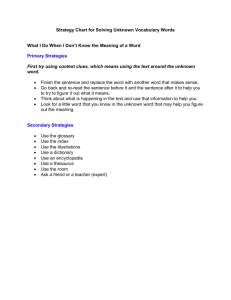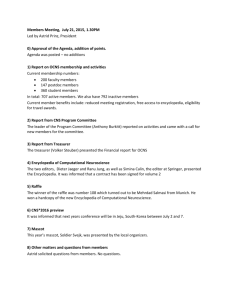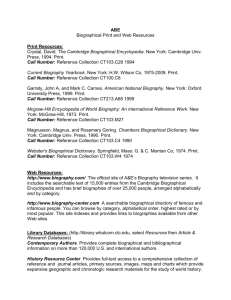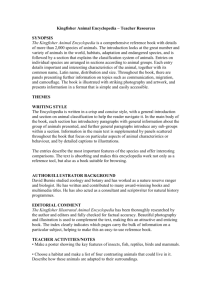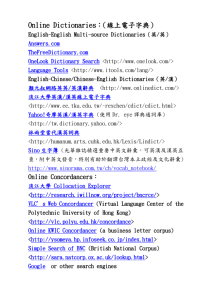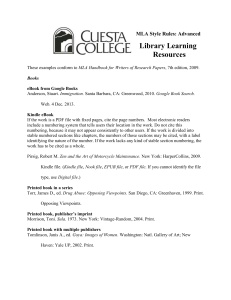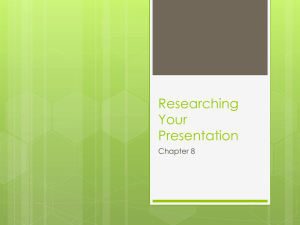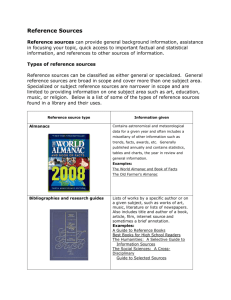Exam Questions Reference 1 Final
advertisement
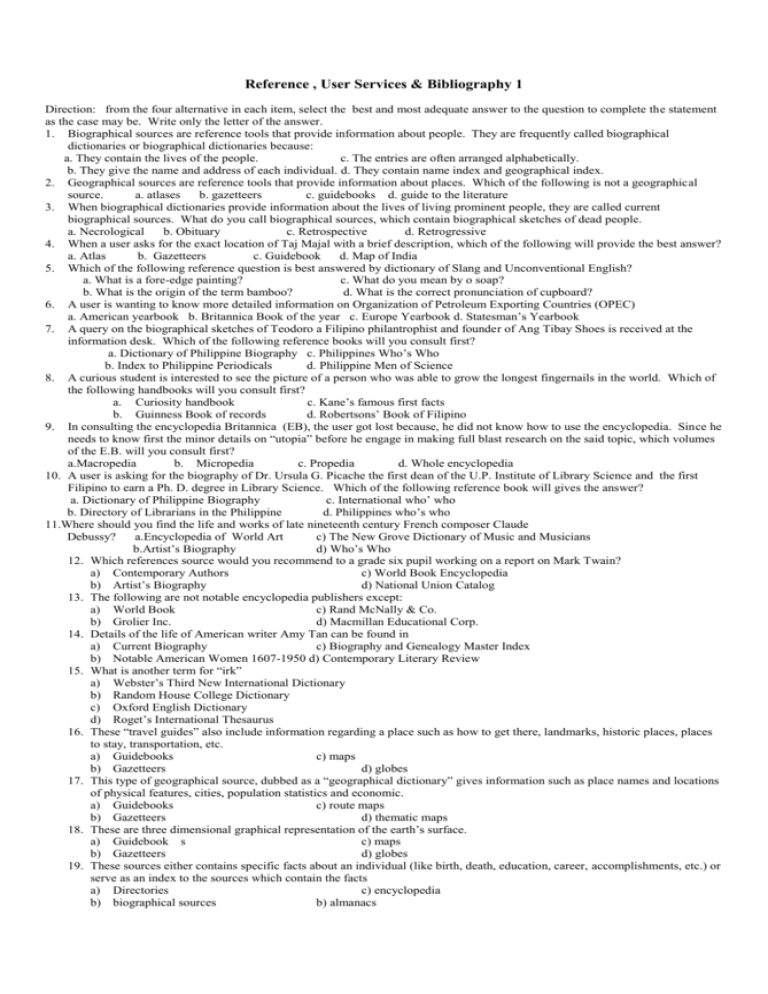
Reference , User Services & Bibliography 1 Direction: from the four alternative in each item, select the best and most adequate answer to the question to complete the statement as the case may be. Write only the letter of the answer. 1. Biographical sources are reference tools that provide information about people. They are frequently called biographical dictionaries or biographical dictionaries because: a. They contain the lives of the people. c. The entries are often arranged alphabetically. b. They give the name and address of each individual. d. They contain name index and geographical index. 2. Geographical sources are reference tools that provide information about places. Which of the following is not a geographical source. a. atlases b. gazetteers c. guidebooks d. guide to the literature 3. When biographical dictionaries provide information about the lives of living prominent people, they are called current biographical sources. What do you call biographical sources, which contain biographical sketches of dead people. a. Necrological b. Obituary c. Retrospective d. Retrogressive 4. When a user asks for the exact location of Taj Majal with a brief description, which of the following will provide the best answer? a. Atlas b. Gazetteers c. Guidebook d. Map of India 5. Which of the following reference question is best answered by dictionary of Slang and Unconventional English? a. What is a fore-edge painting? c. What do you mean by o soap? b. What is the origin of the term bamboo? d. What is the correct pronunciation of cupboard? 6. A user is wanting to know more detailed information on Organization of Petroleum Exporting Countries (OPEC) a. American yearbook b. Britannica Book of the year c. Europe Yearbook d. Statesman’s Yearbook 7. A query on the biographical sketches of Teodoro a Filipino philantrophist and founder of Ang Tibay Shoes is received at the information desk. Which of the following reference books will you consult first? a. Dictionary of Philippine Biography c. Philippines Who’s Who b. Index to Philippine Periodicals d. Philippine Men of Science 8. A curious student is interested to see the picture of a person who was able to grow the longest fingernails in the world. Which of the following handbooks will you consult first? a. Curiosity handbook c. Kane’s famous first facts b. Guinness Book of records d. Robertsons’ Book of Filipino 9. In consulting the encyclopedia Britannica (EB), the user got lost because, he did not know how to use the encyclopedia. Since he needs to know first the minor details on “utopia” before he engage in making full blast research on the said topic, which volumes of the E.B. will you consult first? a.Macropedia b. Micropedia c. Propedia d. Whole encyclopedia 10. A user is asking for the biography of Dr. Ursula G. Picache the first dean of the U.P. Institute of Library Science and the first Filipino to earn a Ph. D. degree in Library Science. Which of the following reference book will gives the answer? a. Dictionary of Philippine Biography c. International who’ who b. Directory of Librarians in the Philippine d. Philippines who’s who 11.Where should you find the life and works of late nineteenth century French composer Claude Debussy? a.Encyclopedia of World Art c) The New Grove Dictionary of Music and Musicians b.Artist’s Biography d) Who’s Who 12. Which references source would you recommend to a grade six pupil working on a report on Mark Twain? a) Contemporary Authors c) World Book Encyclopedia b) Artist’s Biography d) National Union Catalog 13. The following are not notable encyclopedia publishers except: a) World Book c) Rand McNally & Co. b) Grolier Inc. d) Macmillan Educational Corp. 14. Details of the life of American writer Amy Tan can be found in a) Current Biography c) Biography and Genealogy Master Index b) Notable American Women 1607-1950 d) Contemporary Literary Review 15. What is another term for “irk” a) Webster’s Third New International Dictionary b) Random House College Dictionary c) Oxford English Dictionary d) Roget’s International Thesaurus 16. These “travel guides” also include information regarding a place such as how to get there, landmarks, historic places, places to stay, transportation, etc. a) Guidebooks c) maps b) Gazetteers d) globes 17. This type of geographical source, dubbed as a “geographical dictionary” gives information such as place names and locations of physical features, cities, population statistics and economic. a) Guidebooks c) route maps b) Gazetteers d) thematic maps 18. These are three dimensional graphical representation of the earth’s surface. a) Guidebook s c) maps b) Gazetteers d) globes 19. These sources either contains specific facts about an individual (like birth, death, education, career, accomplishments, etc.) or serve as an index to the sources which contain the facts a) Directories c) encyclopedia b) biographical sources b) almanacs 20. Lists of particular institutions like schools, museums, libraries, hospitals, foundations, etc. are called a) government directories c) professional directories b) institutional directories d) trade and business directories 21. Telephone books, city directories and directories of specialized groups within the community are actively known as a) local directories c) professional directories b) governmental directories d) institutional directories 22. This reference set presents a clear picture of the purpose and functions of the social work profession: a. Phil. Encyclopedia of Social Sciences c. Encyclopedia of the Philippines b. The Encyclopedia of Social Work d. Phil. Legal Encyclopedia 23. This reference set focuses on the Philippine art in all forms (performing, music, etc.) a. Flora de Pilipinas c. Pictorial Encyclopedia of Phil. Plants b. CCP Encyclopedia of Philippine Art d. Encyclopedia of Folk & Beliefs 24. It puts together the Philippine folk beliefs and customs collated from published works: a. Encyclopedia of Social Work c. Encyclopedia of Social Science b. Encyclopedia of Phil. Folk Beliefs & Customs d. Booklet of Knowledge 25. This is a 10-volume work claimed as a comprehensive, readable and reliable history of the Filipino people because each volume is written by one or more of the country’s most authoritative experts in the field. There is an index and the list of sources in the end of each volume and a glossary in volume 10. a. Encyclopedia of Spanish American Period c. CCP Encyclopedia b. Kasaysayan: thestory of the Filipino People d. Philippine Science Encyclopedia
